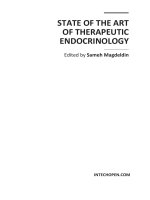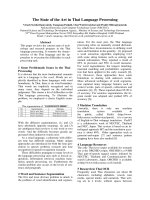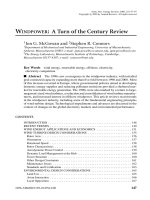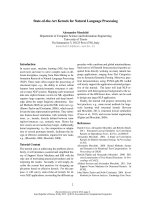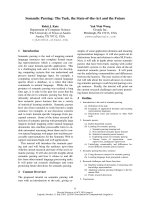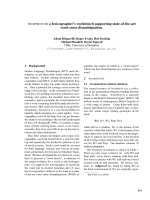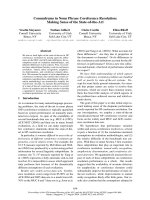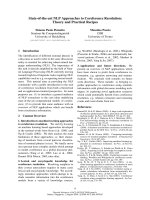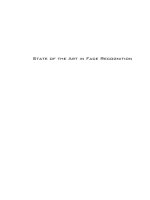A state of the art review tourist decision making literature
Bạn đang xem bản rút gọn của tài liệu. Xem và tải ngay bản đầy đủ của tài liệu tại đây (346.85 KB, 22 trang )
A STATE-OF-THE-ART REVIEW
OF TOURIST DECISION-MAKING LITERATURE
Dung Le1 and Thai Phong Le2
Abstract
Decision-making theories in tourism can be classified into three groups based on their
underlined assumptions: rational choice, affect-driven and dual-process theories. Rational
choice theories are the dominant framework in many fields including economics, political
science, finance, marketing and tourism. Consumers are considered as “rational-decisionmakers” who evaluate available options by rational thinking. In contrast, the affect-driven
theories assume that tourists are hedonic decision-makers and their choice is influenced and
guided by affective factors (i.e., emotions, feelings). Dual-process theories reconcile these two
opposite approaches by proposing a dual-system of decision-making: System 1 related to
automatic, emotional, non-conscious process, and System 2 involving rational thinking. This
review paper provides a general picture of how tourism decision-making literature has been
developed with a focus on the latest advancement, dual-system theories. Tourism marketers
may find this paper beneficial in understanding tourist behaviours, in particular, tourists’
destination choice. Traditional marketing focusing only on rational factors (comparative
messages) can be a dead-end approach, experiential marketing has become the new trends. By
advancing our knowledge of tourist decision-making, this paper provides useful guidelines for
tourism marketers in designing tourist experiences and promoting tourism destinations.
Key words: Tourist behaviour, decision-making, dual-system, destination choice, marketing
Date of receipt: 24th Oct.2017; Date of revision: 15th Mar.2018; Date of approval: 1st Apr.2018
1. Introduction
How tourists choose a destination for their future vacation is one of the key questions in tourism
research. Over the past six decades, tourism has experienced continued expansion and
diversification, to become one of the largest and fastest-growing economic sectors in the world.
The intense competition between traditional and emerging tourism destinations requires
tourism marketers to improve their knowledge about the tourist decision-making process.
Understanding how tourists decide and plan their trips results in important implications for
1
2
PhD student, Griffith University, Australia
Assoc.Prod.Dr., Foreign Trade University. Email:
future product development and promotional schemes (Chen, 2003) as well as marketing
strategies (Sirakaya & Woodside, 2005). There is a growing research base of theoretical and
empirical studies on tourist destination choice and tourist decision-making over the last five
decades (Smallman & Moore, 2010).
Tourism research remains dominated by the assumption of rational decision-making (Cohen,
Prayag, & Moital, 2014; McCabe & Chen, 2015). The rational theories used in tourism
decision-making research adopt one of three major approaches: the normative approach (utility
theory), the prescriptive cognitive approach (the theory of reasoned action & the theory of
planned behaviour) and the structured process approach (the choice-set model). However,
rational decision-making models seem to be problematic in explaining how choices of
experiential products such as vacations are made because they ignore affective factors (Jun &
Vogt, 2013; Kwortnik & Ross, 2007; Lerner, Li, Valdesolo, & Kassam, 2015; Loewenstein &
Lerner, 2003; McCabe & Chen, 2015).
In the 1980s, researchers started to explore how affective factors are involved in tourist
decision-making (Holbrook, 1986; Holbrook & Hirschman, 1982; Litvin, 2008). People rely on
their emotions when choosing hedonic products such as a pleasure vacation (Bechara, 2004;
Mellers, Schwartz, & Ritov, 1999; Pham, 1998; Prayag, Khoo-Lattimore, & Sitruk, 2015;
Schwarz, 2011; Zeelenberg, Nelissen, Breugelmans, & Pieters, 2008). The affect-driven
theories clarify different mechanisms that affect influence consumer behaviours. The impact of
emotions on consumer decision-making is explained by four influential theories including the
feelings-as-information (Schwarz, 2011), the affect-priming (Forgas, 1995), the appraisaltendencies (Lerner & Keltner, 2000) and the feeling-as-doing (Zeelenberg et al., 2008). In
addition, anticipated emotions are supposed to guide consumer behaviour. Decisions are made
to pursue positive anticipated emotions or avoid anticipated emotions such as regret or
disappointment (Baumeister, Vohs, DeWall, & Zhang, 2007; Mellers & McGraw, 2001).
Recently the recognition of affective influence in the consumer decision-making process leads
to the call of reappraising traditional tourist decision-making models (Jun & Vogt, 2013;
McCabe & Chen, 2015). Dual-system theories which incorporate both affective and rational
factors may provide a better explanatory framework to explain consumer decision and choice.
Dual-system theorists agree that the consumer decision-making process involves two systems.
System 1 is experiential, automatic, intuitive and related to affective factors. System 2 is
rational, analytic, reflective and related to rational thinking (Chaiken, 1980; Epstein & Pacini,
1999; Evans, 2006; Kahneman & Frederick, 2002; Lieberman, 2003; Strack & Deutsch, 2006).
The final decision is made based on satisficing principle between two systems (Evans, 2006).
The dual-system theories reflect how people make decisions by incorporating both fast and
slow thinking (Kahneman, 2011). Neuroscience research support dual-system theories by
providing evidence of two neural systems involved in decision-making: an impulsive,
amygdala-dependent system for signalling the pain or pleasure of immediate prospects (i.e.,
system 1)and a reflective, orbitofrontal-dependent system for signalling the prospects of the
future (i.e., system 2) (Bechara, Noel, & Crone, 2006).
Against this background, this paper aims to provide a comprehensive summary of what has
been found regarding tourist decision-making research. In order to achieve the research
objective, a state-of-the-art approach is employed to review imagery tourism literature (Grant
& Booth, 2009). As state-of-the-art reviews tend to address more current matters and to offer
new perspectives on the topic studied, the papers are then selected based on the authors’
assessment of their relevance and significance to advance imagery-related knowledge in
tourism (Cohen et al., 2014). The remainder of this paper is hence organised into two sections.
Section 1 is to summarise the research findings related to tourist decision-making. Section 2
focuses on discussing the research gaps with purposes of suggesting an agenda for future
research.
2. Findings
2.1 Rational theories in tourism
The rational choice theories are based on the assumption that consumers are rational decision
makers and utility maximisers. This view of “consumer-as-rational-decision-maker” has been
investigated from two perspectives: the macro-perspective (i.e. general models) used to study
the social-psychological context and the inputs that influence individual decisions; and the
micro-perspective (i.e. operational models) for better explaining actual decision-making
outcomes (McCabe & Chen, 2015). From the macro-perspective, the earliest and most
influential models of consumer behaviour sought to provide a systematic understanding of the
consumer buying decision for tangible, manufactured products (Engel, Kollat, & Blackwell,
1968; Howard & Sheth, 1969). According to these early studies, the decision-making process
includes a series of well-defined stages: (1) recognition of need, (2) search for information, (3)
evaluation of alternatives, (4) choice and (5) post-purchase (Engel et al., 1968). The entire
tourist decision-making process has been similarly conceptualised as a multi-phased process:
anticipation (planning and thinking about the trip), travel to the site, on-site behaviour, return
travel and recollections of experiences (reflection and memory of trip) (Clawson & Knetsch,
1966). However, these macro-perspective models do not describe how consumers evaluate
alternatives to make their decision. The complexity and difficulty of their operationalization
have resulted in a lack of empirical support for these models (McCabe & Chen, 2015). Other
criticisms of such macro-perspective models include their failure to incorporate emotional,
social and symbolic influencers on consumer decision-making (Holbrook & Hirschman, 1982),
as well as the social characteristics of consumer behaviour and decision-making contexts
(Decrop & Kozak, 2009).
From a micro-perspective, there are three different approaches (Table 1): a normative utility
approach, the prescriptive cognitive approach (theory of reasoned action and theory of planned
behaviour) and the choice-set models (McCabe & Chen, 2015). The first two analyses the
decision-making process as an input-output process: the normative approach considers product
attributes as input and a decision as output; while the prescriptive cognitive approach uses
psychological concepts (e.g. attitude, subjective norms, and behavioural control) as input and
intention to purchase as the output. The third type, choice-set models, explain decisions as the
result of a filtering process (Smallman & Moore, 2010). The normative and prescriptive models
focus on how optimal decisions should be made while a descriptive model (e.g. choice-set)
describes how consumers make decisions in a series of steps (Tamura, 2008).
Table 1: Different rational approaches in decision-making literature
Basic
assumption
Influential
theories
Contribution
Limitations
Normative utility
Consumer follows a
utility-maximisation
principle.
Expected Utility
Theory (Von
Neumann &
Morgenstern, 1947)
Characteristic Utility
Theory (Lancaster,
1966)
Explain how
consumers should
make decisions based
on the evaluation of
product attributes or
characteristics
Poorly explain
consumer decisions
under risk or
uncertainty
(Kahneman &
Tversky, 1979)
Prescriptive cognitive
Consumer behaviour is
planned. The intention
is the antecedent of
behaviour.
Theory of Reasoned
Action (TRA) (Fishbein
& Ajzen, 1977)
Theory of Planned
Behaviour (TPB)
(Ajzen, 1991)
Choice-set
Consumer follows a funnellike process to narrow
choices until the final
decision is made
Choice-set theory (Howard,
1963)
Choi-set model (Woodside
& Sherrell, 1977)
Choice-set model (Spiggle
& Sewall, 1987)
Consumer behaviour
intention is influenced
by their beliefs and past
behaviour.
- Describe how consumer
decisions are actually made
- Help marketers to define
their main competitors
- Neglect affective
factors (Godin & Kok,
1996; Perugini &
Bagozzi, 2001)
- Do not explain
unplanned behaviours
(i.e., impulsive
purchase)
- Simplifying consumer
choices by a binary logic of
selecting or rejecting a
destination (Decrop, 2010).
- Reasons for selecting a
destination can differ
considerably from reasons
for rejecting a destination to
the extent that actual
choices may be based on a
process of elimination
Application in
tourism
Papatheodorou (2001)
Seddighi and
Theocharous (2002)
Tussyadiah, Kono, and
Morisugi (2006)
rather than of selection
(Perdue & Meng, 2006)
March and Woodside Crompton (1992)
(2005)
Decrop (2010)
Lam and Hsu (2006)
H. Han, Hsu, and Sheu
(2010)
Sources: Summarised by the authors
As the tourist decision-making process is unlikely to fit neatly into a single decision theory,
recent research tends to apply more than a decision-making theory (Sirakaya & Woodside,
2005). For example, a number of tourism studies explain tourists’ destination choice based on
both the TPB and the Lancaster’s Characteristic Utility theory. Tourist attitude toward a
destination is calculated by the sum of the attitudes toward experiencing the destination’s
perceived attributes (e.g. the likelihood of experiencing each attribute) (Crompton, 1992; Yoo
& Chon, 2008). Some aspects of Prospect Theory (Kahneman & Tversky, 1979) such as
perceived risk and perceived uncertainty have been integrated into the TPB model to explain
the formation of attitudes and behavioural control (Quintal, Lee, & Soutar, 2010).
Rational theories have been strongly criticised for neglecting affective factors (Gnoth, 1997;
Loewenstein & Lerner, 2003; McCabe & Chen, 2015; Sirakaya & Woodside, 2005). There is
neuroscience evident of the affective involvement in decision-making. Patients with
orbitofrontal brain damage who cannot process emotional information, have severe impairment
in judgment and decision-making in real-life (Bechara, Damasio, & Damasio, 2000; Damasio,
1994). The affect-driven theories in decision-making theories are discussed in the next section.
2.2 Affect-driven theories in tourism
In opposition to the view of “consumer-as-rational-decision-maker”, the perspective of
“consumer-as-hedonic-person” highlights the important role of affective factors in the decisionmaking process (Hyde et al., 1999). Two main approaches have been identified (Table 2): the
affect-as-direct-cause and the affect-as-feedback (DeWall, Baumeister, Chester, & Bushman,
2015). The affect-as-direct-cause focus on explaining different influencing mechanisms of
experienced emotions at the decision moment including feeling-as-information theory
(Loewenstein, Weber, Hsee, & Welch, 2001; Schwarz, 1990) affect priming theory (Forgas,
1995), appraisal tendency theory (Lerner & Keltner, 2000) and the feeling-is-for-doing theory
(Zeelenberg et al., 2008). The second approach (affect-as-feedback) argues that people make
decisions based on the anticipation of the decision’s affective consequences (Wilson, Lisle,
Kraft, & Wetzel, 1989). Important affect-as-feedback theories include regret theory (Bell, 1982;
Loomes & Sugden, 1982), disappointment theory (Bell, 1985; Loomes & Sugden, 1986),
subjective expected pleasure (Mellers & McGraw, 2001), and emotion-as-feedback theory
(Baumeister et al., 2007).
Both the affect-as-direct-causation and the affect-as-feedback approached has provided
important findings on how emotions are involved in the consumer decision-making process
(Achar, So, Agrawal, & Duhachek, 2016; Lerner et al., 2015). A meta-analysis of research from
these two theoretical perspectives shows that anticipated emotions may have more reliable
impacts on consumer behaviour than experienced emotions (DeWall et al., 2015). The
recognition of both affective and rational factors in the consumer decision-making process leads
to the development of dual-system theories. This latest trend of research in decision-making
literature will be reviewed in the next section.
Table 2: Affect-driven approaches in decision-making
Affect as direct causation
Affect as feedback
Assumption
Experienced affect (e.g., emotions, Consumer decisions are made based on
feelings) influences consumer judgment the
anticipation
of
affective
and decision-making.
consequences
(i.e.,
anticipated
emotions).
Influential
Feelings-as-information
theory Regret theory (Bell, 1982; Loomes &
theories
(Schwarz, 1990; Schwarz & Clore, 1996) Sugden, 1982)
Affect infusion model – AIM (Forgas, Disappointment theory (Bell, 1985;
1995)
Loomes & Sugden, 1986), Subjective
Appraisal tendency theory (Lerner & expected pleasure (Mellers &
Keltner, 2000)
McGraw, 2001)
Risk-as-feelings theory (Loewenstein et Emotion-as-feedback
theory
al., 2001)
(Baumeister et al., 2007).
Feeling-is-for-doing theory (Zeelenberg
et al., 2008)
Contribution
Explaining different mechanisms that Consumer behaviour can be guided or
experienced affect can influence shaped by anticipated emotions
consumer behaviour
Limitations
If the consumer has formed an appraisal- Anticipated emotions are not the only
based impression of the product, the determinants of participants’ decisions.
affect that they experience subsequently Consumer perception of risk and
has a limited impact (Yeung & Wyer, others’ decisions have direct influences
2004).
on individual choices independently of
Emotions do not necessarily lead directly their mediating impact on anticipated
to behavior (e.g., mood-freezing) emotions (Fong & Wyer Jr, 2003)
(Baumeister et al., 2007)
Application in Pham (1998)
Fong and Wyer Jr (2003)
marketing & Chang and Pham (2013)
Hunter (2006)
tourism
Han, Lerner, and Keltner (2007)
Chun, Patrick, and MacInnis (2007)
Prentice (2006)
Carrera, Caballero, and Munoz (2012)
Kim, Njite, and Hancer (2013)
Bagozzi, Belanche, Casaló, and
Flavián (2016)
Sources: Summarised by the authors
2.3 Dual-system theories in tourism
According to dual-system theories, consumers make decisions based two distinct cognitive
systems: system 1 is unconscious (preconscious), automatic, rapid, effortless and holistic while
system 2 is conscious (rational), controlled, slow, effortful and analytic (Evans, 2008). A
number of influential dual-system theories include experiential and rational systems (Epstein
& Pacini, 1999), the theory of intuitive and reflective judgment (Kahneman & Frederick, 2002),
heuristic and analytic systems (Evans, 2006), reflexive and reflective systems (Lieberman,
2003), reflective and impulsive systems (Strack & Deutsch, 2006), heuristic-systematic model
(Chaiken & Ledgerwood, 2011). The dual-system approach is supported by neuroscience
evidence of two neural systems described as an impulsive, amygdala-dependent system for
signalling the pain or pleasure of immediate prospects and a reflective, orbitofrontal-dependent
system for signalling the prospects of the future (Bechara et al., 2006).
Table 3: Overview of some influential dual-system theories
Name of theory
System 1
Elaboration likelihood Peripheral route related
model
(Petty
& to
low-effort
Wegener, 1999)
mechanism
Experiential
and
rational
systems
(Epstein & Pacini,
1999)
Intuitive and reflective
judgment (Kahneman
& Frederick, 2002)
Reflexive
and
reflective
systems
(Lieberman, 2003)
Heuristic and analytic
systems (Evans, 2006)
Reflective
and
impulsive
systems
(Strack & Deutsch,
2006)
Heuristic-systematic
model (Chaiken &
Ledgerwood, 2011)
System 2
Relationship between
two systems
Central route based on Default-interventionist
relatively
extensive
and
effortful
information processing
Rational system related Parallel-competitive
to logical thinking
Experiential
system
related
to
preconscious,
rapid
thinking
Intuitive system related Reflective
system
to affective content
related to abstract
content
based
on
effortful thinking
X-system (reflexive) C-system (reflective)
related to affect and related
to
further
social meaning
reasoning
Heuristic
process Analytic
process
generating
deriving
judgments
representations
of from
these
problem content,
representations
Impulsive
system Impulsive
system
operating as a fast and related to rule-based
automatic information reasoning
processing network
Heuristic
system Systematic
system
focusing on salient and involving
careful
easily comprehended attention,
deep
cues derived from thinking and intensive
well-learned
reasoning
judgmental shortcuts
Default-interventionist
Default-interventionist
Default-interventionist
Parallel-competitive
Parallel-competitive
Source: Summarised by the author
Dual-system theories differ on the role of affect and the interactions between two processes
described (Evans, 2008). Firstly, affective factors are explicitly (Epstein & Pacini, 1999; Evans,
2006; Kahneman & Frederick, 2002) or implicitly (Chaiken & Ledgerwood, 2011; Lieberman,
2003; Strack & Deutsch, 2006) linked to System 1. Secondly, dual-system theories can be
distinguished based on their “default-interventionist” (Evans, 2006; Kahneman & Frederick,
2002; Lieberman, 2003) versus “parallel-competitive” (Chaiken, 1980; Epstein & Pacini, 1999)
assumptions. The dual-system approach has received two main types of criticism: (1) there are
multiple kinds of implicit processes described by different theorists and (2) not all of the
proposed attributes of the two kinds of processing can be sensibly mapped into two systems as
currently conceived (Evans, 2008).
There is also an increasing number of marketing & tourism studies in accordance with dualsystem theories. Consumer behaviour is explained by two intervening response systems in
parallel: information-processing system related to conventional Cognition-Affect-Behaviour
(CAB) paradigm and experiential system related to fantasies and feelings (Holbrook &
Hirschman, 1982). The Consciousness-Emotion-Value (CEV) differs from the CAB paradigm
by involving three phases of consumption experience: consciousness, emotions and value
(Holbrook, 1986). According to the CEV model, emotions shape value in the consumption
experience. The influence of both affective and rational factors in consumer decision-making
process has been studied in numerous studies by Bagozzi and collaborators (Bagozzi,
Baumgartner, Pieters, & Zeelenberg, 2000; Bagozzi, Dholakia, & Basuroy, 2003; Bagozzi,
Gopinath, & Nyer, 1999; Bagozzi & Pieters, 1998). The Model of Goal-Directed Behaviour
(Perugini & Bagozzi, 2001) and the Model of Effortful Decisions (Bagozzi et al., 2003)
incorporate anticipated emotions into the theory of planned behaviours to better explain
consumer behaviour. In order to better explain tourist choices, a general model of tourist
decision-making has been proposed by (McCabe, Li, & Chen, 2016) (Figure 1).
Figure 1: General model of tourist decision-making
Source: Adapted from McCabe et al. (2016)
3. DISCUSSION
The development of dual-system theories consists of the latest advancement in understanding
tourist decision-making. Even though a general model of dual-system theories has been
developed in tourism literature, many questions remained related to tourist involvement and the
contextual factors that influence how tourists engage in one or both decision-making system as
well as the role of emotions.
3.1 Tourist involvement in decision-making
The general model presented in this paper visualizes how both systems are involved in the
dynamic decision-making process of tourists. It is suggested by McCabe et al. (2016) that tourist
involvement play an important role in differentiate tourist engagement in System 1 or System
2. Tourists may engage System 1 which is affect-driven if their involvement is low. In contrast,
if they are more likely to engage in System 2 if their involvement is high. This is because in
low-involvement situation, tourists may lack of commitment to apply logic and statistics to
make decisions. The level of involvement can be determined by the level of personal relevance
(Jun & Vogt, 2013). However, individual differences such as the need for cognition (Cacioppo
& Petty, 1982) or faith in intuition (Epstein, Pacini, Denes-Raj, & Heier, 1996) may influence
tourist level of involvement in making decisions. Much further research is needed to explore
how these factors influence tourist involvement which in turn determines the system employed
for decision-making process. The application of experimental research can help to advance our
knowledge in this area.
3.2 The role of emotions in tourist decision-making
Dual-system theories provide more support for the recognition of affective factors in tourist
decision-making. There is an increasing number of studies recognising the important impact of
emotions on consumer decision (Cohen, Pham, & Andrade, 2008; Hirschman & Holbrook,
1982; Holbrook, 1986; Holbrook & Hirschman, 1982). In the case of experiential products such
as vacation, the connection between emotions and behaviour may be stronger and more direct
than the connection between attitude and behaviour (Bagozzi, Gurhan-Canli, & Priester, 2002).
emotions can impact consumer decisions directly and indirectly (Kwortnik & Ross, 2007).
When emotional responses to consumer imagery are consciously experiences, they can be used
as information for consumer decision-making (Greifeneder, Bless, & Pham, 2010; Loewenstein
et al., 2001; Pham, 1998; Schwarz, 1990). The effects of emotions on consumer decision are
more pronounced for experiential products such as vacation than utilitarian products (M. Pham,
Geuens, & De Pelsmacker, 2013). In addition, emotional responses to the imagery provide a
proxy to determine anticipated emotions (Gilbert & Wilson, 2007; Wilson & Gilbert, 2003,
2005). Anticipated emotions refer to affective predictions or belief (i.e. cognition) (Bagozzi,
Belanche, Casaló, & Flavián, 2016; Chun et al., 2007; Hunter, 2006; Mellers et al., 1999) that
guide and shape consumer decisions (Baumeister et al., 2007; Mellers & McGraw, 2001). Less
conscious-experienced emotions can also engender indirect effects on consumer behaviours by
mobilising analytical thinkings (Kwortnik & Ross, 2007). The appraisal tendencies theory (Han
et al., 2007) and the affect-priming theory (Forgas, 1995) provide theoretical support for the
indirect route of emotional influence in the model.
Even though the role of emotions and feelings have been investigated by a number of studies,
more questions remained unanswered. One of the biggest questions is related to the
psychological process of emotion elicitation, future research on emotions in the decisionmaking process is needed to fill the gap (Lerner et al., 2015). Appraisal theories have been
tested and validated in psychology and marketing literature to study the phenomenon of
emotions (Ellsworth, 2013; Hosany, 2011; Johnson & Stewart, 2005; Ma, Gao, Scott, & Ding,
2013; Moors, Ellsworth, Scherer, & Frijda, 2013). However, no previous research has explored
appraisal variables to explain the elicitation of emotions (Zeelenberg et al., 2008) except the
study of Hung and Mukhopadhyay (2012) related to agency. Hence, appraisal theories are
introduced in the next section as an explanatory approach of the complex nature and process of
emotions (Ellsworth & Scherer, 2003; Frijda, 1986; Lazarus, 1991; Scherer, 1984). The second
question related to the interaction between integrated emotions (emotions elicited by the
decision-related factors) and incidental emotions (emotions caused by contextual factors)
(Lerner et al., 2015). One sunny day may put decision-makers in a good mood which in turn
influence favourably their decisions.
3.3 Contextual factors that influence tourist decision-making
The application of dual-system theories in tourist behaviour research results in the necessity of
investigating the factors that influence tourist engagement in different systems. Tourism
researchers should focus on identifying the influencing factors in marketing and psychology
literatures to test them in tourism context. Moreover, the relationship between these factors such
as cognitive load, time constraints remained subjects to be investigated in future research.
Another interesting research topic is how these two systems operate together.
3.4. Marketing applications of dual-system theories
Tourism is moving to become the experience-selling industry where experiential benefits such
as fantasy, feelings and fun play important roles on tourist decision-making processing
(Holbrook & Hirschman, 1982). In the experience economy (Pine & Gilmore, 1998), the job of
tourism marketers is to deliver and manage tourist experiences instead of traditional job of
promoting tourism products/services (Kim, 2017). Figure 2 shows that how tourist experiences
offer more added value to tourism business than traditional product/service. In order to design
and deliver tourist experiences, rational decision-making theories seem to be inadequate to
explain tourist behaviours and decisions (Kwortnik & Ross, 2007; McCabe et al., 2016). The
application of dual-system theories which include both rational factors and affective factors
provides a better framework.
Figure 2: Example of the experiences spectrum of wine
Source: Tourism and Events Queensland, 2017
Tourism marketing has been also adapted to these new research findings. Traditional marketing
that is designed based on rational theories try to convince potential tourists based on rational
factors of tourist decision-making. However, experiential marketing which focuses on creating
fantasy, enhance tourist emotions is now considered as an effective way to promote a
destination and persuade potential tourists (Petrova & Cialdini, 2008). Emotions can be used as
a criteria of market segmentation (Bigne & Andreu, 2004). Some DMOs have led the way of
applying experiential marketing. For example, Tourism and Event Queensland have recently
developed a number of “hero experience” programs which highlights different types of
experiences that tourists can have during their pleasure vacations in Queensland. (Source: Teq
website, 2017). These new marketing initiatives are developed based on the recognition of both
rational and affective factors that can influence tourist decisions. The use of both comparative
messages (rational factors) and experiential messages (afective factors) in tourism marketing
can enhance the effectiveness of tourism marketing campaigns.
4. CONCLUSION
The explanatory power of rational decision-making models has been questioned in case of
purchasing experiential products such as vacations (Jun & Vogt, 2013; McCabe & Chen, 2015;
Pham, 1998; Prentice, 2006; Walls, Okumus, & Wang, 2011). Tourists seek fantasy, feelings
and fun in their holidays (Hirschman & Holbrook, 1982; Holbrook, 1986; Holbrook &
Hirschman, 1982; Litvin, 2008). These experiential aspects, in turn, have a role to play in tourist
decision-making process (Decrop & Snelders, 2004; Goossens, 2000; Kwortnik & Ross, 2007;
Prentice, 2006). The development of dual-system theories offers a bigger picture of how both
rational and affective factors are involved in tourist decision-making. The application of dualsystem theories in tourism research consists of a significant advancement in understanding
tourist behaviours and results in benefitial application for DMOs. More research is still needed
to better explore how these two systems interact as well as other contextual antecedents of
tourist dual-system decisions.
References
Achar, C., So, J., Agrawal, N., & Duhachek, A. (2016). What we feel and why we buy: the
influence of emotions on consumer decision-making. Current Opinion in Psychology, 10, 166170. doi: />Ajzen, I. (1991). The theory of planned behavior. Organizational Behavior and Human Decision
Processes, 50(2), 179-211.
Bagozzi, R., Baumgartner, H., Pieters, R., & Zeelenberg, M. (2000). The role of emotions in
goal-directed behavior. In S. Ratneshwar, D. Mick, & H. Cynthia (Eds.), The why of
consumption: Contemporary perspectives on consumer motives, goals, and desires (pp. 36-58).
USA: Routledge.
Bagozzi, R., Belanche, D., Casaló, L., & Flavián, C. (2016). The Role of Anticipated Emotions
in Purchase Intentions. Psychology & Marketing, 33(8), 629-645.
Bagozzi, R., Belanche, D., Casaló, L. V., & Flavián, C. (2016). The Role of Anticipated
Emotions in Purchase Intentions. Psychology & Marketing, 33(8), 629-645.
Bagozzi, R., Dholakia, U., & Basuroy, S. (2003). How effortful decisions get enacted: The
motivating role of decision processes, desires, and anticipated emotions. Journal of Behavioral
Decision Making, 16(4), 273-295.
Bagozzi, R., Gopinath, M., & Nyer, P. (1999). The role of emotions in marketing. Journal of
the academy of marketing science, 27(2), 184-206.
Bagozzi, R., Gurhan-Canli, Z., & Priester, J. (2002). The social psychology of consumer
behaviour. UK: McGraw-Hill Education.
Bagozzi, R., & Pieters, R. (1998). Goal-directed emotions. Cognition & Emotion, 12(1), 1-26.
Baumeister, R., Vohs, K., DeWall, N., & Zhang, L. (2007). How emotion shapes behavior:
Feedback, anticipation, and reflection, rather than direct causation. Personality and Social
Psychology Review, 11(2), 167-203.
Bechara, A. (2004). The role of emotion in decision-making: evidence from neurological
patients with orbitofrontal damage. Brain and cognition, 55(1), 30-40.
Bechara, A., Damasio, H., & Damasio, A. R. (2000). Emotion, Decision Making and the
Orbitofrontal Cortex. Cerebral Cortex, 10(3), 295-307. doi:10.1093/cercor/10.3.295
Bechara, A., Noel, X., & Crone, E. (2006). Loss of willpower: abnormal neural mechanisms of
impulse control and decision making in addiction. In W. Reinout & S. Alan (Eds.), Handbook
of implicit cognition and addiction (pp. 215-232). USA: SAGE publications.
Bell, D. (1982). Regret in decision making under uncertainty. Operations research, 30(5), 961981.
Bell, D. (1985). Disappointment in decision making under uncertainty. Operations research,
33(1), 1-27.
Bigne, J. E., & Andreu, L. (2004). Emotions in segmentation: An empirical study. Annals of
Tourism Research, 31(3), 682-696.
Cacioppo, J. T., & Petty, R. E. (1982). The need for cognition. Journal of personality and social
psychology, 42(1), 116.
Carrera, P., Caballero, A., & Munoz, D. (2012). Future oriented emotions in the prediction of
binge drinking intention and expectation: the role of anticipated and anticipatory emotions.
Scandinavian journal of psychology, 53(3), 273-279.
Chaiken, S. (1980). Heuristic versus systematic information processing and the use of source
versus message cues in persuasion. Journal of personality and social psychology, 39(5), 752766.
Chaiken, S., & Ledgerwood, A. (2011). A theory of heuristic and systematic information
processing. In P. Van Lange, A. Kruglanski, & T. Higgins (Eds.), Handbook of theories of
social psychology: Volume one (pp. 246-166). UK: Sage Publications Ltd.
Chang, H., & Pham, M. (2013). Affect as a decision-making system of the present. Journal of
Consumer Research, 40(1), 42-63.
Chen, J. (2003). Market segmentation by tourists’ sentiments. Annals of Tourism Research,
30(1), 178-193. doi: />Chun, H., Patrick, V., & MacInnis, D. (2007). Making prudent vs. impulsive choices: the role
of anticipated shame and guilt on consumer self-control. In G. Fitzsimons & V. Duluth (Eds.),
NA-Advances in Consumer Research (Vol. 34, pp. 715-719): MN : Association for Consumer
Research.
Clawson, M., & Knetsch, J. (1966). Economics of outdoor education: Baltimore MD: John
Hopkins Press.
Cohen, J., Pham, M., & Andrade, E. (2008). The nature and role of affect in consumer behavior.
In C. Haugtvedt, P. Herr, & F. Kardes (Eds.), Handbook of consumer psychology (pp. 297348). New York, London: Taylor & Francis group, LLC.
Cohen, S., Prayag, G., & Moital, M. (2014). Consumer behaviour in tourism: Concepts,
influences and opportunities. Current Issues in Tourism, 17(10), 872-909.
Crompton, J. (1992). Structure of vacation destination choice sets. Annals of Tourism Research,
19(3), 420-434.
Damasio, A. (1994). Descartes’ error: Emotion, rationality and the human brain. New York:
Putnam
Decrop, A. (2010). Destination choice sets: An inductive longitudinal approach. Annals of
Tourism Research, 37(1), 93-115.
Decrop, A., & Kozak, M. (2009). Decision strategies in tourism evaluation. In M. Kozak & A.
Decrop (Eds.), Handbook of tourist behavior: Theory & practice (pp. 69-82). UK: Routledge,
Taylor & Francis group.
Decrop, A., & Snelders, D. (2004). Planning the summer vacation: An adaptable process.
Annals of Tourism Research, 31(4), 1008-1030.
DeWall, N., Baumeister, R., Chester, D., & Bushman, B. (2015). How often does currently felt
emotion predict social behavior and judgment? A meta-analytic test of two theories. Emotion
Review, 8(2), 136-143. doi:10.1177/1754073915572690
Ellsworth, P. (2013). Appraisal theory: Old and new questions. Emotion Review, 5(2), 125131.
Ellsworth, P., & Scherer, K. (2003). Appraisal processes in emotion. In R. Davidson, K.
Scherer, & H. Goldsmith (Eds.), Handbook of affective sciences (pp. 572-595). New York:
Oxford University Press.
Engel, J., Kollat, D., & Blackwell, R. (1968). Consumer behavior. New York: Holt, Rinehart,
and Winston.
Epstein, S., & Pacini, R. (1999). Some basic issues regarding dual-process theories from the
perspective of cognitive-experiential self-theory. In S. Chaiken & Y. Trope (Eds.), Dualprocess theories in social psychology (pp. 462-482). USA: The Guilford Press.
Epstein, S., Pacini, R., Denes-Raj, V., & Heier, H. (1996). Individual differences in intuitive–
experiential and analytical–rational thinking styles. Journal of personality and social
psychology, 71(2), 390.
Evans, J. (2006). The heuristic-analytic theory of reasoning: Extension and evaluation.
Psychonomic Bulletin & Review, 13(3), 378-395.
Evans, J. (2008). Dual-processing accounts of reasoning, judgment, and social cognition. Annu.
Rev. Psychol., 59, 255-278.
Fishbein, M., & Ajzen, I. (1977). Belief, attitude, intention, and behavior: An introduction to
theory and research. Philosophy and Rhetoric, 10(2), 130-132.
Fong, C., & Wyer Jr, R. (2003). Cultural, social, and emotional determinants of decisions under
uncertainty. Organizational Behavior and Human Decision Processes, 90(2), 304-322.
doi: />Forgas, J. (1995). Mood and judgment: the affect infusion model (AIM). Psychological bulletin,
117(1), 39-66.
Frijda, N. (1986). The emotions: Studies in emotion and social interaction. Paris: Maison de
Sciences de l'Homme.
Gilbert, D., & Wilson, T. (2007). Prospection: Experiencing the future. Science, 317(5843),
1351-1354.
Gnoth, J. (1997). Tourism motivation and expectation formation. Annals of Tourism Research,
24(2), 283-304.
Godin, G., & Kok, G. (1996). The theory of planned behavior: a review of its applications to
health-related behaviors. American journal of health promotion, 11(2), 87-98.
Goossens, C. (2000). Tourism information and pleasure motivation. Annals of Tourism
Research, 27(2), 301-321.
Grant, M. J., & Booth, A. (2009). A typology of reviews: an analysis of 14 review types and
associated methodologies. Health Information & Libraries Journal, 26(2), 91-108.
Greifeneder, R., Bless, H., & Pham, M. T. (2010). When do people rely on affective and
cognitive feelings in judgment? A review. Personality and Social Psychology Review, 15(2),
107-141.
Han, H., Hsu, L.-T., & Sheu, C. (2010). Application of the Theory of Planned Behavior to green
hotel choice: Testing the effect of environmental friendly activities. Tourism Management,
31(3), 325-334. doi: />Han, S., Lerner, J., & Keltner, D. (2007). Feelings and Consumer Decision Making: The
Appraisal-Tendency Framework. Journal of Consumer Psychology, 17(3), 158-168.
doi: />Hirschman, E., & Holbrook, M. (1982). Hedonic consumption: emerging concepts, methods
and propositions. The Journal of Marketing, 46(3), 92-101.
Holbrook, M. (1986). Emotion in the consumption experience: toward a new model of the
human consumer. The role of affect in consumer behavior: Emerging theories and applications,
6(23), 17-52.
Holbrook, M., & Hirschman, E. (1982). The experiential aspects of consumption: Consumer
fantasies, feelings, and fun. Journal of Consumer Research, 9(2), 132-140.
Hosany, S. (2011). Appraisal determinants of tourist emotional responses. Journal of Travel
Research, 51(3), 303-314. doi:10.1177/0047287511410320
Howard, J. (1963). Marketing management: Analysis and planning. New York: RD Irwin.
Howard, J., & Sheth, J. (1969). The theory of buyer behavior. New York: John Wiley.
Hung, I., & Mukhopadhyay, A. (2012). Lenses of the heart: How actors’ and observers’
perspectives influence emotional experiences. Journal of Consumer Research, 38(6), 11031115.
Hunter, G. (2006). The role of anticipated emotion, desire, and intention in the relationship
between image and shopping center visits. International Journal of Retail & Distribution
Management, 34(10), 709-721.
Hyde, K., Woodside, A., Crouch, G., Mazanec, J., Oppermann, M., & Sakai, M. (1999). A
hedonic perspective on independent vacation planning, decision-making and behaviour.
Consumer psychology of tourism, hospitality and leisure., 177-209.
Johnson, A., & Stewart, D. (2005). A reappraisal of the role of emotion in consumer behavior.
Review of marketing research, 1, 3-33.
Jun, S.-H., & Vogt, C. (2013). Travel information processing applying a dual-process model.
Annals of Tourism Research, 40, 191-212.
Jun, S. H., & Vogt, C. (2013). Travel information processing applying a dual-process model.
Annals of Tourism Research, 40, 191-212.
Kahneman, D. (2011). Thinking, fast and slow. New York: Farrar, Straus and Giroux.
Kahneman, D., & Frederick, S. (2002). Representativeness revisited: Attribute substitution in
intuitive judgment. In T. Gilovich, D. Griffin, & D. Kahneman (Eds.), Heuristics and biases:
The psychology of intuitive judgment. New York: Cambridge University Press
Kahneman, D., & Tversky, A. (1979). Prospect theory: An analysis of decision under risk.
Econometrica: Journal of the econometric society, 47(2), 263-292.
Kim, J.-H. (2017). The Impact of Memorable Tourism Experiences on Loyalty Behaviors: The
Mediating Effects of Destination Image and Satisfaction. Journal of Travel Research, 1-15.
doi:10.1177/0047287517721369
Kim, Y., Njite, D., & Hancer, M. (2013). Anticipated emotion in consumers’ intentions to select
eco-friendly restaurants: Augmenting the theory of planned behavior. International Journal of
Hospitality Management, 34, 255-262. doi: />Kwortnik, R., & Ross, W. (2007). The role of positive emotions in experiential decisions.
International Journal of Research in Marketing, 24(4), 324-335.
Lam, T., & Hsu, C. (2006). Predicting behavioral intention of choosing a travel destination.
Tourism Management, 27(4), 589-599.
Lancaster, K. J. (1966). A New Approach to Consumer Theory. The Journal of Political
Economy, 74(2), 132-157.
Lazarus, R. (1991). Progress on a cognitive-motivational-relational theory of emotion.
American psychologist, 46(8), 819.
Lerner, J., & Keltner, D. (2000). Beyond valence: Toward a model of emotion-specific
influences on judgement and choice. Cognition & Emotion, 14(4), 473-493.
Lerner, J., Li, Y., Valdesolo, P., & Kassam, K. (2015). Emotion and decision making. Annual
review of psychology, 66, 799–823.
Lieberman, M. D. (2003). A social cognitive neuroscience approach. In J. Forgas, K. Williams,
& W. von Hippel (Eds.), Social judgments: Implicit and explicit processes (pp. 44-67). UK:
Cambridge University Press.
Litvin, S. W. (2008). Sensation seeking and its measurement for tourism research. Journal of
Travel Research, 46(4), 440-445.
Loewenstein, G., & Lerner, J. (2003). The role of affect in decision making. Handbook of
affective science, 619(642), 3.
Loewenstein, G., Weber, E., Hsee, C., & Welch, N. (2001). Risk as feelings. Psychological
bulletin, 127(2), 267.
Loomes, G., & Sugden, R. (1982). Regret theory: An alternative theory of rational choice under
uncertainty. The economic journal, 92(368), 805-824.
Loomes, G., & Sugden, R. (1986). Disappointment and dynamic consistency in choice under
uncertainty. The Review of Economic Studies, 53(2), 271-282.
Ma, J., Gao, J., Scott, N., & Ding, P. (2013). Customer delight from theme park experiences:
The antecedents of delight based on cognitive appraisal theory. Annals of Tourism Research,
42, 359-381.
March, R., & Woodside, A. (2005). Testing theory of planned versus realized tourism behavior.
Annals
of
Tourism
Research,
32(4),
905-924.
doi: />McCabe, S., & Chen, Z. (2015). Time for a Radical Reappraisal of Tourist Decision Making?
Toward a New Conceptual Model. Journal of Travel Research, 55(1), 3-15.
McCabe, S., Li, C., & Chen, Z. (2016). Time for a radical reappraisal of tourist decision
making? Toward a new conceptual model. Journal of Travel Research, 55(1), 3-15.
Mellers, B., & McGraw, P. (2001). Anticipated emotions as guides to choice. Current
Directions in Psychological Science, 10(6), 210-214.
Mellers, B., Schwartz, A., & Ritov, I. (1999). Emotion-based choice. Journal of Experimental
Psychology: General, 128(3), 332.
Moors, A., Ellsworth, P., Scherer, K., & Frijda, N. (2013). Appraisal theories of emotion: State
of the art and future development. Emotion Review, 5(2), 119-124.
Papatheodorou, A. (2001). Why people travel to different places. Annals of Tourism Research,
28(1), 164-179. doi: />Perdue, R., & Meng, F. (2006). Understanding choice and rejection in destination consideration
sets. Tourism Analysis, 11(6), 337-348.
Perugini, M., & Bagozzi, R. (2001). The role of desires and anticipated emotions in goal
directed behaviours: Broadening and deepening the theory of planned behaviour. British
Journal of Social Psychology, 40(1), 79-98.
Petrova, P., & Cialdini, R. (2008). Evoking the imagination as a strategy of influence.
Handbook of consumer psychology, 505-524.
Petty, R., & Wegener, D. (1999). The elaboration likelihood model: Current status and
controversies. In S. Chaiken & Y. Trope (Eds.), Dual-process theories in social psychology.
USA: The Guilford Press.
Pham, M., Geuens, M., & De Pelsmacker, P. (2013). The influence of ad-evoked feelings on
brand evaluations: Empirical generalizations from consumer responses to more than 1000 TV
commercials. International Journal of Research in Marketing, 30(4), 383-394.
Pham, M. T. (1998). Representativeness, relevance, and the use of feelings in decision making.
Journal of Consumer Research, 25(2), 144-159.
Pine, J., & Gilmore, J. (1998). Welcome to the experience economy. Harvard business review,
76, 97-105.
Prayag, G., Khoo-Lattimore, C., & Sitruk, J. (2015). Casual Dining on the French Riviera:
Examining the Relationship Between Visitors’ Perceived Quality, Positive Emotions, and
Behavioral Intentions. Journal of Hospitality Marketing & Management, 24(1), 24-46.
Prentice, R. (2006). Evocation and experiential seduction: Updating choice-sets modelling.
Tourism Management, 27(6), 1153-1170. doi:10.1016/j.tourman.2005.11.008
Quintal, V., Lee, J. A., & Soutar, G. (2010). Risk, uncertainty and the theory of planned
behavior:
A
tourism
example.
Tourism
Management,
31(6),
797-805.
doi: />Scherer, K. (1984). On the nature and function of emotion: A component process approach. In
Scherer, Klaus R., Ekman, Paul. Approaches to emotion, 293-318.
Schwarz, N. (1990). Feelings as information: informational and motivational functions of
affective states: Guilford Press.
Schwarz, N. (2011). Feelings-as-information theory. Handbook of theories of social
psychology, 1, 289-308.
Schwarz, N., & Clore, G. (1996). Feelings and phenomenal experiences. Social psychology:
Handbook of basic principles, 2, 385-407.
Seddighi, H., & Theocharous, A. (2002). A model of tourism destination choice: a theoretical
and
empirical
analysis.
Tourism
Management,
23(5),
475-487.
doi: />Sirakaya, E., & Woodside, A. G. (2005). Building and testing theories of decision making by
travellers. Tourism Management, 26(6), 815-832.
Smallman, C., & Moore, K. (2010). Process studies of tourists' decision-making. Annals of
Tourism Research, 37(2), 397-422. doi: />Spiggle, S., & Sewall, M. (1987). A choice sets model of retail selection. The Journal of
Marketing, 97-111.
Strack, F., & Deutsch, R. (2006). Reflective and impulsive determinants of consumer behavior.
Journal of Consumer Psychology, 16(3), 205-216.
Tamura, H. (2008). Behavioral models of decision making under risk and/or uncertainty with
application
to
public
sectors.
Annual
Reviews
in
Control,
32(1),
99-106.
doi: />Tussyadiah, I., Kono, T., & Morisugi, H. (2006). A model of multidestination travel:
implications for marketing strategies. Journal of Travel Research, 44(4), 407-417.
Von Neumann, J., & Morgenstern, O. (1947). Theory of games and economic behavior (2 ed.).
USA: Princeton University Press.
Walls, A., Okumus, F., & Wang, Y. (2011). Cognition and affect interplay: A framework for
the tourist vacation decision-making process. Journal of Travel & Tourism Marketing, 28(5),
567-582.
Wilson, T., & Gilbert, D. (2003). Affective forecasting. Advances in experimental social
psychology, 35, 345-411.
Wilson, T., & Gilbert, D. (2005). Affective forecasting knowing what to want. Current
Directions in Psychological Science, 14(3), 131-134.
Wilson, T., Lisle, D., Kraft, D., & Wetzel, C. (1989). Preferences as expectation-driven
inferences: effects of affective expectations on affective experience. Journal of personality and
social psychology, 56(4), 519.
Woodside, A., & Sherrell, D. (1977). Traveler evoked, inept, and inert sets of vacation
destinations. Journal of Travel Research, 16(1), 14-18.
Yeung, C., & Wyer, R. (2004). Affect, appraisal, and consumer judgment. Journal of Consumer
Research, 31(2), 412-424.
Yoo, J., & Chon, K. (2008). Factors affecting convention participation decision-making:
Developing a measurement scale. Journal of Travel Research.
Zeelenberg, M., Nelissen, R., Breugelmans, S., & Pieters, R. (2008). On emotion specificity in
decision-making: Why feeling is for doing. Judgment and Decision-making, 3(1), 18–27.
Website
Tourism
and
Event
Queensland,
2017,
/>
retrieval
at
